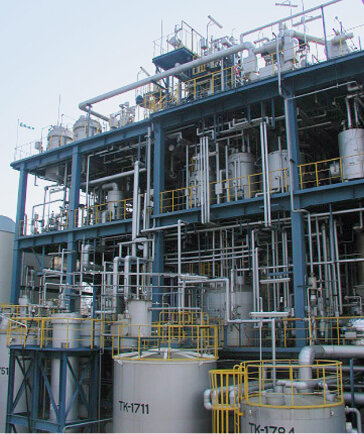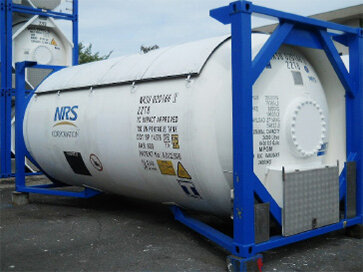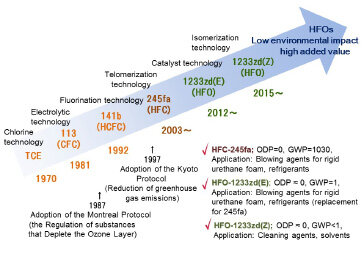R&D
Next-generation blowing agent with low global warming potential and low environmental impact contributes to the prevention of global warming
-
Article categories:
- Environment
-
Related businesses:
- Applied Chemicals
- Social issue
- Protection of the ozone layer, stopping global warming
- Central Glass's engagement
- Development of fluorocarbon replacements with extremely low global warming potential that will not deplete the ozone layer
Fluorine-based blowing agents are widely used for the rigid urethane foam insulation used in office building and home walls and ceilings, as well as in refrigerators and freezers. Currently, these blowing agents are hydrofluorocarbon (HFC), non-ozone depleting fluorocarbon materials. Central Glass is the only company in Japan that is manufacturing and supplying HFC-245fa. However, the global-warming potential (GWP) of HFCs is high, so going forward there will be a growing demand for low-GWP materials that prevent global warming. The following is an introduction of Central Glass's technologies relating to next-generation blowing agents that are not ozone-depleting substances. These technologies are environmentally friendly and have low global-warming potential (low environmental impact).
Background to Development
Central Glass has been a manufacturer of caustic soda since from its earliest days. In the <1}1970s, we began the production of chlorinated solvents (1,1,1-Trichloroethane). From there, in the early 1980s we developed and began manufacturing nonflammable, low-toxicity fluorine-based solvents (CFC-113) that were widely used in cleaning applications. The late 1980s witnessed a growing international awareness of the problem of ozone layer destruction. The Montreal Protocol was signed in 1987, banning specific chlorofluorocarbons, and Central Glass commenced research to find replacements for these specific chlorofluorocarbons. In the early 1990s, we replaced CFC-113 with HCFC-141b and commercialized its use as a solvent and as a blowing agent in the production of rigid urethane foam.
However, although small, HCFC-141b does have a certain ozone-depleting potential (ODP), so Central Glass began development work on a zero-ODP HFC. We began the production of HFC-245fa in 2003, and put it on the market as a blowing agent for rigid polyurethane foam. After that, the use of HFCs expanded to include refrigerants, blowing agents, solvents and cleaning agents. Nevertheless, a new problem arose with the increased use of these materials: There was a growing debate about global-warming potential as a factor of carbon dioxide (which GWP is standardized to 1).
Since HFCs are extremely stable compounds, they typically have higher global-warming potential on the order of several hundreds to thousands.
That is why HFCs were identified as gases subject to reductions in use within the context of the debates leading to the Kyoto Protocol that followed the Montreal Protocol.
Given the direction in which the international community was moving, Central Glass started research at the beginning of the new century on initiatives toward the development of zero-ODP, low-GWP next-generation compounds, and identified HFOs (hydrofluoroolefins) as strong candidates with the desired characteristics. We focused our efforts on the development of HFO production technology and product development. In 2012, Central Glass began producing and supplying HFO-1233zd(E) (zero-ODP, GWP=1) as a replacement for HFC-245fa blowing agent, and in 2015, HFO-1233zd (Z) to replace HCFC-225 solvent.

Approach to Development
In the field of fluorine chemistry, an enormous amount of progress has been made in the fluororesin industry that primarily uses the <1}C2 compound tetrafluroethylene (TFE) as a raw material.
On the other hand, rather than moving in the direction of fluororesin, Central Glass switched over from HCFC-141b to HFC-245fa, going forward with the development of telomerization technology in which C1 compounds having a carbon number of 1 and C2 compounds having a carbon number of 2 are caused to undergo an addition reaction to obtain C3 compounds having a carbon number of 3, thus opening the way for C3 compounds.
In particular, we established catalyst and industrial process technology in telomerization reactions and have developed HFC-245fa. We focused our efforts on developing processes to ensure mild fluorination reactions in HFC-245fa production, and developed proprietary production technology that facilitates the switching production of HFC-245fa and HFO-1233zd (E).
This basic technology has resulted in today's large-scale HFO production technology. In October 2012, Central Glass began industrial-scale manufacturing of HFO-1233zd (E), a world's first. We will continue our efforts to develop diverse HFO compound production processes and products.

(Used with the cooperation of NRS Corp.)
Keys to Success
Establishment of HFC-245fa production technology
The establishment of production technology for HFC-245fa marks a major turning point in many years of fluorocarbon-related research and development. With the advent of production technology for C3 compounds (telomerization and fluorination technology), the industry is no longer dependent on C1 compounds or C2 compounds. This greatly expands the potential for fluorocarbon materials having diverse physical properties that can be used (material variations). In this process, a fundamental and important factor leading to the successful development of HFOs was in figuring out the basics of HFOs. It took more than just R&D to develop HFCs and HFOs; the fact that we have superior industrial production technology <2}is one of the strengths of Central Glass.

Isomerization reactions
In recent HFO development activities, Central Glass R&D has focused its attention on isomerization reactions. We believe that this will lead to the development of still more HFOs. Going forward, we will build on the foundation of HFOs to supply blowing agents, refrigerants, solvents and cleaning agents and proceed with research & development to implement new materials that meet the many different needs of the market.
